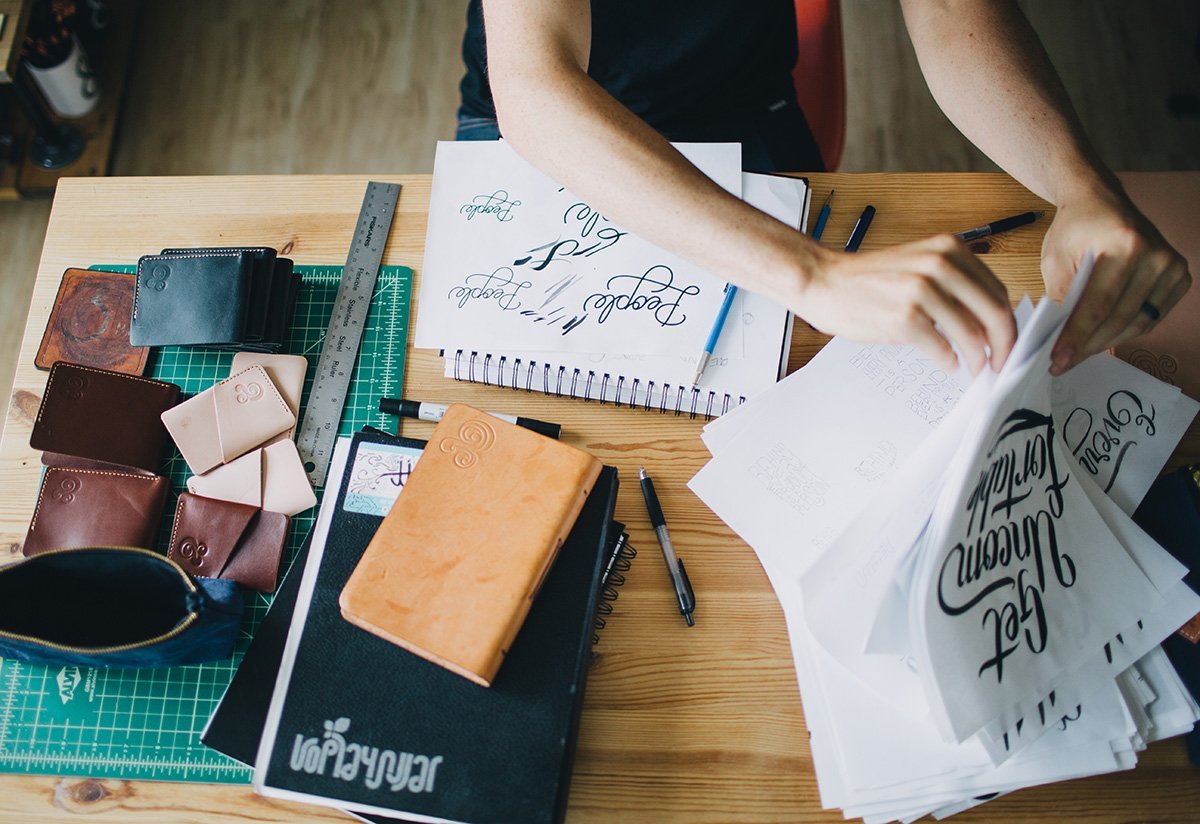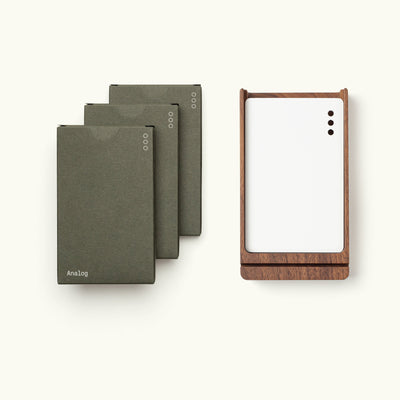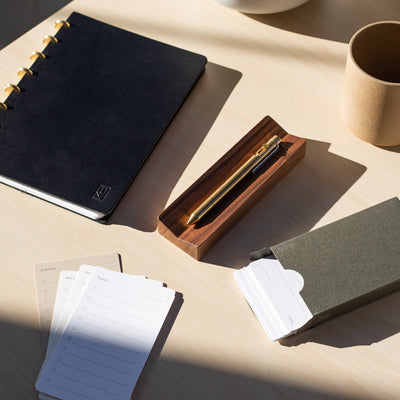One of the most frequent questions I get asked is…
"How do you come up with new ideas?"I think people are hoping I’ll answer with a specific website or resource that will unlock all of my creative secrets. But the reality is that there isn’t one magic source. For me, coming up with new ideas isn’t exactly an event. I think of it more as a cumulative, evolving process rather than a simple exercise that I sit down and do. It’s about always being aware of things around me, both online and offline, and filing them away for future reference. (I’ll get into how I actually do this further down in this post). Ever since I was kid, I’ve always noticed obscure details and picked up on things that most people walk right past. I’d spend hours searching for the “perfect” rock to add to my rock collection, analyzing each one until I found the one I liked best. Or I'd stare out the window on long car rides mesmerized by the signage, buildings, changing landscapes, and other cars we drove past. Sometimes, this obsessive observation can come back to bite me. There are times when I get distracted and completely zone out of a conversation or walk right past a street I was supposed to turn on. But paying attention to specific details, textures, lighting, and environments is an ongoing process to train my eye.
Being a good designer is less about technical skills and more about the way I interpret the world.Even though I’ve been designing for over 10 years, it’s something I’m continually getting better at. These small bits of inspiration that I pick up from all around me have a cumulative effect on my design thinking and ideation process. It’s not about looking for one specific thing, but more about letting those ideas organically come to me.
While there’s no “trick” to finding inspiration and discovering the “next big idea,” here are some helpful tips:
1. Capture where you are
It doesn’t matter if you are on a cross-country flight, taking a shower, or sitting at your desk. Just make sure to capture your idea in some form. Write a note on a piece of paper that’s close by (doesn’t have to be a fancy sketchbook), type a note on your phone (I use Simplenote), or record a quick voice memo. There’s even special waterproof paper for capturing ideas in the shower. I don’t know how many times I’ve thought of something and decided to wait to capture it, only to find the idea has completely slipped my mind. We like to think, "There’s no possible way I’ll forget this," but humans are actually pretty terrible at remembering things. Jot it down, or even write it on your hand if you have to. Just make sure to physically capture the idea the moment it strikes. (Exception: don’t pull your phone out and interrupt a conversation with a friend.) To organize and keep track of all of my ideas, I keep a running list in Dropbox Paper (the specific app doesn't matter, just use any app that fits your workflow). Once I’m ready to jump into a project in more detail, I create a new Paper document to compile all of my concepts, references, and thoughts.2. The worst way to get new ideas
Sitting in a cubicle under fluorescent lights, staring at your computer screen and aimlessly browsing the web, is probably the worst way to come up with new ideas, yet so many of us do it. There’s nothing inherently wrong with working in a boring space, but it can tend to narrow our thinking into the same old things we see every day. Change your environment. Go outside. Go for a walk in the woods. Go work from a coffee shop or space you don’t normally find yourself in. There’s something about changing your environment that can be really helpful in triggering new inspiration. Example: We came up with the original idea for Ugmonk 2.0 while we were staying at this awesome house in West Virginia last year. Being in a different environment away from our normal distractions allowed us to see things from a new perspective and pull together several smaller ideas into a whole new vision for Ugmonk.3. The importance of bad ideas
The beauty of true brainstorming is that there’s no such thing as a bad idea. Too often, we restrict ourselves from adding an idea to the list or shouting out a totally ridiculous idea when brainstorming. Even if you’re thinking, "This is the dumbest idea ever," write it down. You never know what it might lead to. Sometimes those “dumb” ideas are the creative spark for another idea that you never would have thought of. Example: The idea to create leather mousepads was originally just an afterthought. We were selling our natural leather journals that wear in over time and thought it might be fun to see how a mousepad would evolve the more it was used. I wasn’t sure if anyone else still used a mousepad, but we decided to do a super small run of them as a test. And here we are years later with our mousepads as one of our biggest sellers! Who would have thought?4. The best ideas
The best ideas almost always come from solving one of your own problems or something you’ve personally encountered. Too often, we get caught up in looking at what everyone else is doing and trying to do the same thing in a different way. There are endless possibilities for what you can come up with, and many niches that are completely untapped. Don’t think too narrowly. Sometimes the best idea is to take two things that already exist, and combine or integrate them somehow. You don’t have to reinvent the wheel. You just have to be the first one to put the wheel on the axle. Or to make a more beautiful, more durable wheel with a story that tells itself. Example: I didn’t invent the ampersand. I didn’t invent minimalist design. And I certainly didn’t invent t-shirts. But I saw the gap in the market for well-designed, minimalist tees that were high quality and sold at a fair price. I combined these things to create Ugmonk. I’ve stayed consistent and true to that vision for eight years now. Sure, Ugmonk’s style has evolved and progressed over the years, but if I changed the core style of our products every season or every year, Ugmonk would be just another watered-down lifestyle brand.The litmus test for new ideas
The first test that I put an idea through is to sleep on it. I write it down, leave it, and come back to it in a day or two. Does the idea still seem to have legs? Am I still excited about it? If so, the next test is doing research to see if it’s already been done by someone else and how I can spin the idea to make it my own. If it passes that test, I run it by a few friends or family members to get their opinions on it. (The only caveat with asking close friends and family is that your mom might think every idea is a good idea, but that’s OK. Thanks, Mom!). I don’t base the validity of my idea solely on other people’s opinions, but as I show them my ideas, I might start to hear a recurring theme about what people like or don’t like about it. Then, the last step is to figure out if my idea is possible and what steps it will take to make it a reality. This last step is the most challenging (and usually frustrating) part of the whole process. Coming up with ideas is actually the easy part. Executing on those ideas is where most people give up. Turning an idea into a tangible product to launch and sell is a long, grueling process, but the end result is incredibly rewarding.While I’d like to say there’s a magic formula that I have for coming up with new ideas, the reality is that it’s not that clear cut. Ideation is not something that can be forced. It must be nurtured. These tips make it easier for me, and I hope they’ll help you, too.


